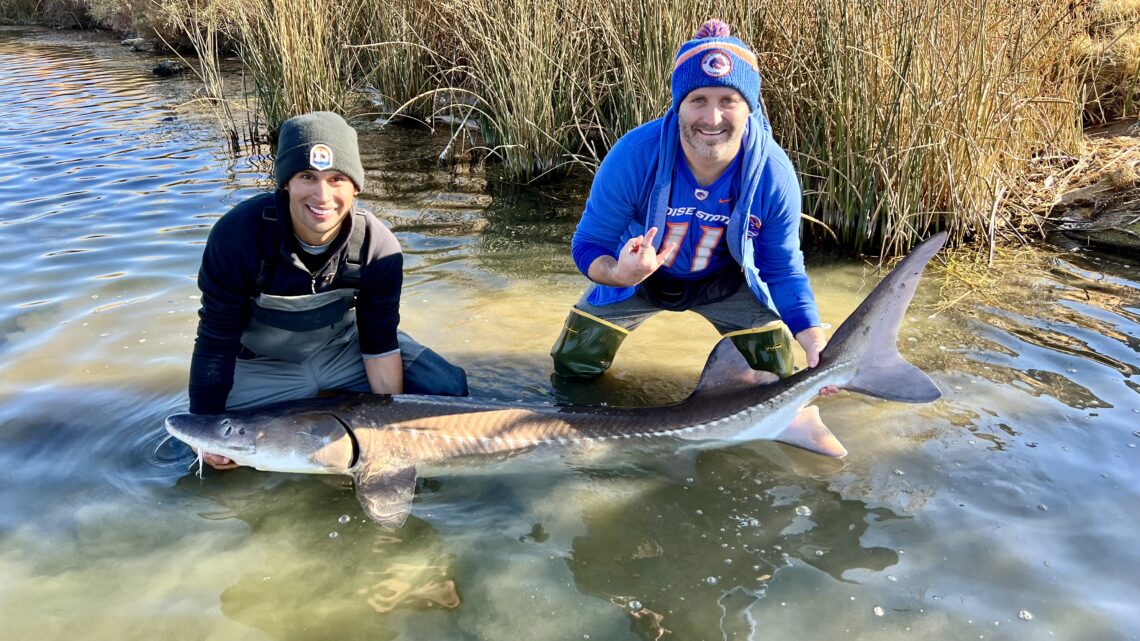
Every time I catch a sturgeon, I am amazed by these majestic, prehistoric creatures. To have a thriving population of Snake River giants—which can outlive humans and grow to more than 10 feet long—swimming in our own backyard is incredible.
If you’ve never caught a sturgeon, it’s a one-of-a-kind fishing experience. I was reminded of this on a recent trip when my buddy Skyler, a lifelong Idaho angler, hooked into a sturgeon for the first time.
“This,” he said, wide-eyed as a 7-foot sturgeon peeled 100 yards of line off his reel. “Is next-level stuff!”
It totally is. And late winter is a great time to give it a try, using these simple steps:
Gear Up. Sturgeon fishing requires special tackle—a big one would destroy traditional bass or trout gear. Idaho Fish and Game requires anglers targeting sturgeon to use stout rods, heavy-duty reels that will hold at least 250 yards of proper line (50+ pound monofilament or 80+ pound braid recommended), barbless hooks (circle hooks strongly encouraged) and sinkers attached to a sliding device via lighter line (so the sinker breaks off before the hook does, keeping baited hooks out of the river). To learn more about proper sturgeon gear, rigging and handling, visit the IDFG website.
Find the Fish
This step is vital, and it can also be tricky. Sturgeon are bottom-dwelling fish, but they move around a lot. During summer, they are often found in the river’s deepest holes, up to 100 feet deep. In cooler weather, they’re perfectly happy in 25 feet of water. Using a fish finder is key to identifying depth, underwater topography and, of course, fish! I’ve picked up some great sturgeon knowledge fishing with my friend Tim Parrish, owner of Hammett Valley Fishing Adventures (I highly recommend him if you want to learn the ropes). Using Tim’s 360-degree electronics, we’ve seen as many as 80 sturgeon packed in an area smaller than a football field! Sturgeon aren’t schooling fish, but they do congregate in places where water temperatures, oxygen levels and food supply are ideal. Once you find such a spot, good times are in store.
Present Your Bait
There is one universal rig for sturgeon fishing—a hunk of bait anchored to the river bottom with a sinker. In light current, like at C.J. Strike Reservoir, a few ounces are enough. In fast-moving stretches of the Snake, anglers may need a pound or more. Favorite baits include pickled herring, squid and fresh cut trout, crappie or pikeminnow. I’ve had the most luck with fresh cut bait, but sturgeon often key in on a bait du jour, so it’s helpful to start with a variety platter. Keep a sharp eye on your lines. Despite their massive size, sturgeon are not aggressive predators. The bite usually manifests with a light “bump, bump, bump,” similar to a finicky trout nosing an ice fishing jig. And then…
Hang on Tight!
The pivotal moment comes when a sturgeon picks up your bait and starts swimming off with it. Rather than a traditional hookset, point the rod down until the line tightens, and then reel as fast as you can to set the circle hook in the corner of the fish’s mouth. Once that’s done, it’s game on! Fighting a sturgeon is a tug-of-war. The fish will make long, line-peeling runs, during which the angler is powerless to slow it down. When the fish stops, apply constant pressure with the rod and winch line back onto the reel. As long as you maintain tension on the line, you’ll land most hookups—but be prepared for a knockdown, drag-out battle. Skyler and I landed four 7-footers that day, and each one took 30-to-40 minutes of physical, arm-burning work. It’s all worth it, though. Getting in the river with an 80-year-old animal (sturgeon are catch-and-release only and must be kept in the water) and feeling it swim away with a sweep of its huge, powerful tail is an experience you’ll never forget. Wrestling a trophy-class Texas alligator gar is the only thing I’ve done that comes close.
Next-level stuff, indeed. Tight lines!